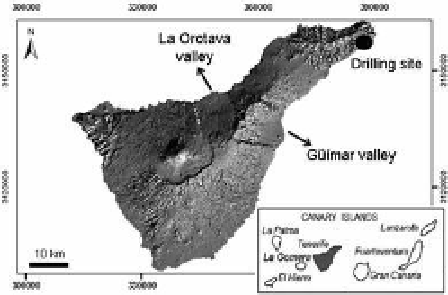Environmental Engineering Reference
In-Depth Information
The role of hyaloclastite rocks in the stability of the volcanic
island flanks of Tenerife
M. Ferrer
Instituto Geológico y Minero de España, Madrid, Spain
J. seisdedos
Prospección y Geotecnia S.L., Madrid, Spain
l.i. González de Vallejo
Universidad Complutense de Madrid, Spain
aBsTRacT: The failure mechanisms that could originate the mega paleo-rockslides of Güímar and la
orotava in Tenerife (canary islands) are analyzed, based on the geomechanical site investigations carried
out on the pre-failure volcanic materials of Tenerife island flanks. Geological and geomorphological mod-
elling and geomechanical characterization of the materials are presented. hyaloclastites rocks are forming
the submarine substratum of the island edifice presenting a highly deformable behaviour. Preliminary
stability analyses have suggested potential failure surfaces in the hyloclastites rocks.
1
inTRoDUcTion
ne direction and maximum heights between 1700
The morphological characteristics of the val-
leys are singular, outstanding the symmetry and
the important height of the lateral scarps (500 m),
formed by pre-landslide volcanic materials with
slope angles higher than 35°. The depressions
formed were filled by post-landslide volcanic mate-
rials with slope angles lower than 15°.
The estimated volume of these rockslides is in
the order of 30-50 km
3
.
The age of Güímar rockslide has been estimated
approximately 1 Ma (Ferrer
et al
., 2008). The age of
la orotava rockslide has been estimated between
0.54 to 0.69 Ma (cantagrel
et al
., 1999).
Güímar and la orotava valleys in Tenerife were
originated by mega rockslides. The resulting slided
masses, deposited on the ocean floor, cover areas
of hundreds of square kilometers. These paleo-
landslides have been considered as ones of the largest
known in the world by their volume. Both constitute
exceptional examples due to their geomorphological
features and the fact that the slided deposits have
been identified in the ocean floor and inside the
galleries excavated in the island (navarro & coello,
1989). in spite of their importance, only few inves-
tigations have been carried out to analyze these
processes under a geomechanical point of view.
The authors are carrying out detailed studies on the
geomechanical properties of the materials involved,
including in situ testing and geophysical surveys,
to evaluate the instability processes of the volcanic
islands flanks (Ferrer
et al
., 2007, 2008).
This paper presents the preliminary results of the
site investigation carried out on the submarine materi-
als formed by hyaloclastites and the role of these rocks
on the stability of the volcanic edifice of Tenerife.
2
GüÍMaR anD la oRoTaVa
RocksliDes
Güímar and la orotava valleys, 9 and 12 km
wide, present opposite orientations, ese and
nnW respectively. Their heads are located in the
Cordillera Dorsal
, main rift zone in the island with
Figure 1. Güímar and la orotava valleys (Tenerife)
and drilling site location.















